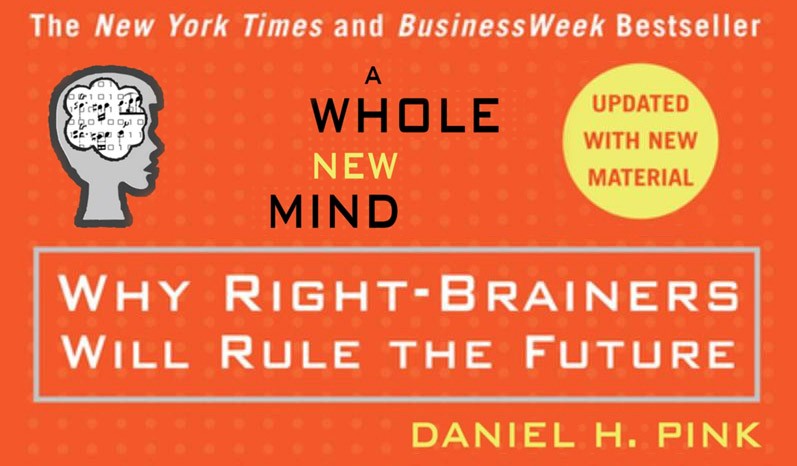A Whole New Mind
by Daniel Pink (2008)

TThis book may be 10 years old, but it is still an interesting read. The rise of abundance, low-cost outsourcing and automation over the past few decades has meant that we have had to rethink our attitudes to the world around us, how we live and work, faster than previous generations ever had to adapt. Now that the world is deeply connected, the pool from which to drive connections has expanded wider than ever before creating unprecedented opportunities.
Connecting ideas and the thinking traditionally thought of as belonging to each half of our brains - Left is analytical and logical - Right is creative and playful - is the key to creating value in the 21st Century, argues Pink. The rise of AI is not dealt with in depth as its emergence into the mainstream has been a more recent phenomenon, but it is a logical extrapolation of automation. Brexit and the hollowing out of the labour pool needed for various industries in this country is more likely to accelerate the deployment of AI and automation to fill the gaps in our manufacturing, agriculture, IT and healthcare industries than the reluctant domestic workforce which prefers to avoid low-paid or seasonal jobs. In our recent history our productivity has also been well behind our peers, although there has been an uptick this year - probably at least partly due to the fact that we know we will start a path of fundamental change to our situations and prospects this time next year - and it's currently not looking good - so let's get as much done as we can while the going is still easy. Nothing motivates like a deadline.
But back to the book. Certainly I've always thought that if you look at the work of great scientists, they start to exhibit artistic traits. This is how you innovate. Silicon doesn't just spontaneously turn into a transistor, it required creative thinking to understand how it could be used to help create a vehicle for computation, and then again for the uses to which the new transistor could be put, etc
Many scientific breakthroughs started life as accidents, but being able to take an accident and then reframe the error as an opportunity for something else is a creative task - think Velcro, Penicillin, the Microwave, Teflon, X-Rays, etc. Likewise, great artists start to exhibit scientific traits in their approach to their work - from an ever deeper understanding of the materials they use to produce their work to the new expressions these enhanced materials can afford them: what makes a better brush? A more powerful camera? A more trouser-flapping bass sound? A more aromatic synthetic vanilla molecule? What can I then do with this new capability? The best minds converge in the same place : part scientific, part artistic. Part left-brained, part right-brained.
For example, Apple places itself at the intersection of science and the liberal arts and their products are testament to this - emphasis on integrating hardware, software and services is a natural and fundamentally strong position from which to grow. This is the theory behind the 'walled garden' approach - if you own the ecosystem you can maintain consistency, quality and privacy. It's no coincidence that more and more companies are adopting this strategy - from Amazon, Google and Tesla to Native Instruments, Roland and Bloomberg. Yes it can be more expensive to maintain that ecosystem, but the customer experience will be more robust, safer and smoother because errors can be corrected much faster than if you are having to hunt through multiple partner systems which may or may not be well integrated.
But as automation is more widely adopted, what about protecting the intellectual property rights that feed the years of innovation to create breakthrough products - including robots and AI? How do you sell your product without giving away the recipe for someone else to make it without the development costs at a lower price?
In the words of Ulrich Spiesshofer, CEO of ABB - a Swiss company that operates in the utility, industry, transport and infrastructure in about 100 countries - that has just inked a deal to double its footprint of robots in China, when asked about IP standards yesterday said:
"We've got to write the book faster than they can read it" - Ulrich Spiesshofer
This is why, even 10 years after it was first written, combining analytical left-brain and symphonic right-brain thinking is ever more necessary to stay ahead.
You can buy a physical copy of Daniel's book here.
Or if you prefer an audiobook, try this.